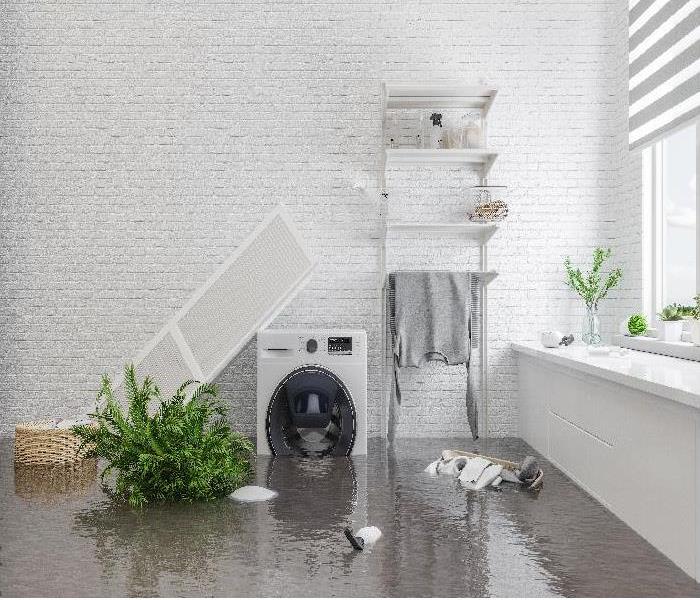How Do I Limit Reconstruction After Flooding in Everett?
4/19/2020 (Permalink)
Our SERVPRO Professionals Work with Efficient Tools and Practices to Protect Your Everett Home and Its Contents from Irreparable Damage
While we might have the skilled professionals on our roster to help with full-scale reconstruction and remodeling as necessary, this is a situation that we seek to avoid as much as possible. Our SERVPRO technicians focus our efforts first and foremost on reducing the need for tear-out and reconstruction whenever possible. After flood losses, this can be a challenge.
Despite how widespread and severe flood damage in Everett homes might initially appear, we can manage these scenarios by breaking the conditions into various mitigation tasks. Each of the processes that encompass the mitigation phase involves a different approach to save customers time and money on the recovery effort their home needs. Much like every other kind of loss, the restoration of a flood involves a blend of our cutting-edge equipment and experienced professionals.
Who Does Flood Debris Removal?
Flood debris can be a substantial threat in your home, especially if contamination is a concern. Getting our team started on clearing out debris and sediment from the affected areas of your house can reduce the concentration of harmful contaminants when applicable, but also set the stage for more efficient cleaning, drying, and resurfacing. The earliest stages in the recovery of your home typically fall into three specific categories:
Muck Out
Flood debris often consists of mud, silt, and many other solids. While this might make efforts like extraction potentially challenging on their own, it also amplifies a need for muck-out debris removal. The presence of potentially contaminated mud and debris can be a hazard to those exposed, making it one of the priorities of our responding SERVPRO technicians.
Controlled Demolition
Minimizing the reconstruction that your home might need after a flood does not mean that no materials might need discarding. Choices about the conditions of exposed materials is a vital service that can showcase the portions of a structural surface damaged and requiring reinstallation. By leaving unaffected materials where they have gotten installed, we can minimize the time for reconstruction later.
Damage Assessment
Before much of the work begins in your home, our project manager and crew chief work with the customer to determine the extent of the damage in the property. Proper evaluations can help to identify problem areas quickly to make better immediate choices about controlled demolition or drying to reduce a later need for reconstruction.
When Does Extraction Begin?
Extraction is often one of the emergency services that our team provides. Standing water, especially after a flood, can be a significant hazard to the occupants of a house. From electric shock hazards to structural degradation, removing surface water can do more to protect your property and help other mitigation activities begin as soon as possible. Extraction can use any of several removal tools in our inventory but often fall into one of three primary categories.
Submersible Pumps
Electric and gas-powered submersible pumps can be vital tools in flood recovery for your house. Clean water flood scenarios can benefit from electric pumps, as they have a longer discharge line and provide a continuously quiet operation. Gas-powered trash pumps must get used when solids are present in the standing water because these units typically have an intake and discharge hose that is at least twice as large as their electric counterparts.
Wet Vacuums
Submersible pumps can only address surface water to a certain extent. Once standing water drops to two inches in depth or less, these pumps lose prime, and wet vacuums are a suitable replacement. A continual suction can remove any lingering water on the surface quickly.
Wands
Attachments for pumps and vacuums can allow for greater versatility in water removal after a flood, especially with clean water flooding that might result from roof breaches. With attachments like carpet wands or squeegee wands, we can remove surface water and much of the saturated water in hard and soft flooring materials.
Can Decontamination and Cleaning Prevent Reconstruction?
After drying has occurred following an extraction, it is necessary to look at what surfaces can get cleaned. Much of the controlled demolition choices have already gotten made at this point, so much of the decontamination and disinfection that might occur in these stages prevents further reconstruction needs.
Allowing the excessive spread and presence of bacteria, viral pathogens, or hazardous microbes can be a threat to the occupants of your home. Properly addressing these concerns is part of the restoration process and recovery effort for your property after a flood loss. Our SERVPRO professionals can utilize potent cleaning products like chlorines and antibacterial chemicals on now-exposed surfaces like wood framing or subflooring.
Flooding can be a destructive force that can often lead to a need for demolition and build back. Reducing a need for widespread replacement involves extraction, drying, and cleaning happening quickly after flooding occurs. Give our SERVPRO of North Everett / Lake Stevens / Monroe team a call 24/7 at (360) 243-8313.
For more about Everett click here.






 24/7 Emergency Service
24/7 Emergency Service
